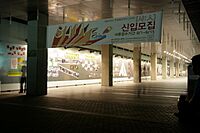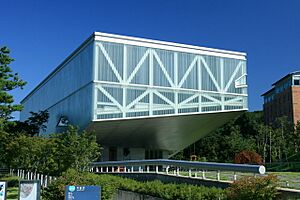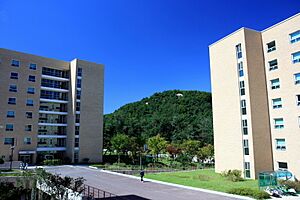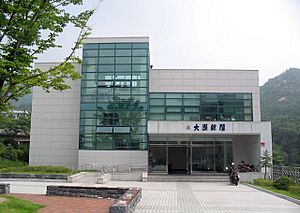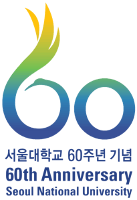Seoul National University facts for kids
|
서울대학교
|
|
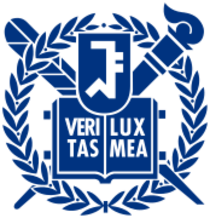 |
|
| Latin: Universitas Nationalis Seulensis | |
| Motto |
Veritas Lux Mea (Latin)
|
|---|---|
|
Motto in English
|
The Truth is My Light |
| Type | National |
| Established | August 22, 1946 |
| President | Ryu Hong-lim (유홍림) |
|
Academic staff
|
2,278 (2022) |
| Students | 28,264 (2022) |
| Undergraduates | 15,870 |
| Postgraduates | 12,394 |
| 4,019 | |
| Location |
Gwanak-gu, Seoul (Gwanak Campus), Jongno-gu, Seoul (Yeongeon Campus), Pyeongchang-gun, Gangwon-do (Pyeongchang Campus), Siheung-si, Gyeonggi-do (Siheung Campus)
,
37°27′36″N 126°57′09″E / 37.46000°N 126.95250°E |
| Campus | Urban, 4.2 km2 (1037 acres) 7.0 km2 (1,729 acres), including the arboreta and other campuses. |
| Colors | SNU Blue |
| Affiliations | AALAU, AEARU, APRU, AUA |
| Mascot | Crane, Zelkova Tree |
| Website | |
 |
|
| Seoul National University | |
| Hangul | |
|---|---|
| Hanja |
서울大學校
|
| Revised Romanization | Seoul Daehakgyo |
| McCune–Reischauer | Sŏul Taehakkyo |
|
Note: Other names such as 漢城國立大學, named after 漢城, the historical Chinese word of Seoul, have been used historically in China.
|
|
Seoul National University (SNU; Korean: 서울대학교; lit. Seoul University) is a top public research university in Seoul, South Korea. It is known as one of the best universities in the country. SNU is also part of the important Flagship Korean National Universities group.
The university has a main campus in Gwanak. It also has two other campuses in Daehangno and Pyeongchang. SNU has sixteen colleges, one graduate school, and nine special professional schools. Almost 17,000 undergraduate students and 11,000 graduate students study here.
Contents
History of Seoul National University
Early Beginnings
Seoul National University (SNU) started from different schools set up by King Gojong of the Joseon dynasty. King Gojong wanted to make Korea more modern. So, he began creating new higher education schools.
For example, a law school called Beopkwan Yangseongso opened in 1895. It trained many legal experts. A teacher training school, Hanseong Sabeomhakgyo, and a medical school, Euihakkyo, also opened in the late 1800s. These early schools became parts of SNU later on.
After the Korean Empire was declared in 1897, more modern schools were created. The medical school, for instance, changed its name several times. It eventually became the College of Medicine at SNU. A nursing department also started in 1901, which led to the College of Nursing.
During the time Japan ruled Korea, a university called Keijō Imperial University was established. After World War II and Korea's independence, this university's name changed to Gyeongseong Daehak. The word "Imperial" was removed, and it became a "National" university.
How SNU Was Formed
SNU was officially created on August 27, 1946. It was formed by bringing together ten different higher education schools in the Seoul area.
Some of the schools that joined to form SNU included:
- Gyeongseong (Seoul) University
- Gyeongseong College of Education
- Gyeongseong Women's College of Education
- Gyeongseong Law College
- Gyeongseong Industrial College
- Gyeongseong Mining College
- Gyeongseong Medical College
- Suwon Agriculture College
- Gyeongseong College of Economics
- Gyeongseong Dentistry College
The first president of SNU was Harry Bidwell Ansted. The university's College of Law was created by combining parts of Kyŏngsŏng University and Kyŏngsŏng Law College. In 1950, Seoul College of Pharmacy also joined SNU.
During the Korean War in 1950, the university had to move temporarily to Busan. It joined with other universities in South Korea for a while.
Moving Campuses
Originally, the main campus of SNU was in Dongsung-dong, Jongno District. In February 1975, a new main campus was built in Gwanak District. Most of the university's colleges moved to this new Gwanak Campus between 1975 and 1979.
However, some parts of the old campus in Jongno-gu are still used. The College of Medicine, College of Dentistry, and College of Nursing are located there. This part of the campus is now called Yeongeon Campus.
In 2012, there was a plan to move the university to Sejong City. This idea was part of a bigger effort to spread out government offices from the capital city. However, the university later thought about not moving to Sejong.
Academics at SNU
Getting Admitted to SNU
Getting into SNU is very difficult. Many of the top students in South Korea try to get in. For example, from 1981 to 1987, more than 80% of the highest-scoring students on the national test applied to SNU. Many of them did not get in.
How SNU is Organized
SNU has sixteen colleges that offer 83 different programs for undergraduate students. For master's and doctoral degrees, there is one graduate school with 99 programs. There are also twelve special professional graduate schools.
Colleges at SNU
- College of Humanities
- College of Social Sciences
- College of Business Administration
- College of Education
- College of Fine Arts
- College of Liberal Studies
- College of Human Ecology
- College of Music
- College of Engineering
- College of Natural Sciences
- College of Agriculture & Life Sciences
- College of Medicine
- College of Nursing
- College of Pharmacy
- College of Veterinary Medicine
Professional Graduate Schools
- Graduate School of Data Science
- Graduate School of Public Health
- Graduate School of Public Administration
- Graduate School of Environmental Studies
- Graduate School of International Studies
- Graduate School of Business
- Graduate School of Convergence Science Technology
- Graduate School of International Agriculture Technology
- Graduate School of Engineering Practice
- School of Law
- School of Dentistry
- School of Medicine
SNU Campuses
Seoul National University has two campuses in Seoul and one in Pyeongchang. The Gwanak Campus is the main one, located in Gwanak-gu. The Yeongeon Campus is for medical studies, located in Daehangno, Jongno District. The newest campus is in Pyeongchang County, Gangwon Province.
Campus Locations
The Gwanak Campus, which is the main campus, is in the southern part of Seoul. It even has its own subway station on Line 2. The Yeongeon Campus, for medical studies, is in Daehangno, northeast Seoul. There used to be an agricultural campus in Suwon, but most of its facilities moved to Gwanak in 2004. Some research facilities are still in Suwon.
Future Campus Plans
In 2010, Seoul National University started plans for a new global campus in the city of Siheung. This new campus will make the university much larger. It will add lecture halls, more liberal arts and graduate courses, and a medical complex. This complex will include a research hospital and a training center. There will also be dormitories, apartments, and an international middle and high school. The university hopes to share this new campus with other schools in the region.
SNU Facilities
The University Library
The Seoul National University Library is a very large library. It is located behind the university's main office building on the Gwanak Campus. As of 2022, the library has 5.2 million books! It also has over 260,000 academic journals and e-journals, plus many other learning materials.
The Central Library also has a digital library. This means you can access university publications, old texts, and student research papers online. It even has images of pamphlets, lecture slides, and insects. You can also watch videos of university exhibitions and scientific events.
The library first opened in 1946. It moved to the Gwanak Campus in 1975 and was renamed the "Seoul National University Library." In 1992, it became the "Seoul National University Central Library."
Kyujanggak Royal Library
The Kyujanggak, also called "Gyujanggak," was the royal library of the Joseon dynasty. It was started in 1776 by King Jeongjo. Today, the Kyujanggak Royal Library is managed by the Kyujanggak Institute for Korean Studies at SNU. It holds many important Korean historical records. It is also a place for research and publishes an annual journal.
The University Museum
The Seoul National University Museum is on the Gwanak Campus. It opened in 1946. The museum moved to new facilities in 1993, where it is located today. It helps preserve and display important historical and cultural items.
Museum of Art
The Seoul National University Museum of Art (SNUMoA) was created in 1995. The building was designed by a famous Dutch architect named Rem Koolhaas. It is a very modern building with a unique design. The museum opened on June 8, 2006, and shows many different types of art.
University Gymnasium
The Seoul National University Gymnasium is a large indoor sports arena. It can hold 5,000 people. It was built in 1986 to host table tennis and badminton events for the 1988 Summer Olympics.
Student Dormitories
The dormitories at SNU are called Gwanaksa (관악사). There are dorms for undergraduate and graduate students, and even for families. Gwanaksa started in August 1975, housing 970 male students. A female dormitory opened in 1983. By 2007, the dorms could house 3,680 students. Unlike many other university dorms in South Korea, there is no curfew.
There is also a dormitory called Yeongeonsa on the Yeongeon campus. This dorm is for students at the medical school. It can house 533 undergraduate students and 17 families.
The University Newspaper
The University Newspaper (대학신문; 大学新闻; Daehak Sinmun) is the school's student newspaper. The first issue was published during the Korean War, on February 4, 1952. It moved to the Gwanak Campus in 1975 and has been published continuously since then. The newspaper is now given out for free every Monday. It is not available during school breaks or exams.
SNU's Reputation and Rankings
| JoongAng National | Domestic | 1 | |
|---|---|---|---|
| QS National | General | 1 | |
| THE National | General | 1 | |
| ARWU National | Research | 1 | |
| QS Asia (Asia version) |
General | 16 | |
| THE Asia (Asia version) |
General | 14 | |
| USNWR Asia | General | =20 | |
| ARWU World | Research | 94 | |
| QS World | General | 31 | |
| THE World | General | 62 | |
| USNWR World | General | =129 | |
SNU's Strong Reputation
Graduates from SNU are very successful in South Korea. They often hold important positions in academics, government, politics, and business. Studies show that having an SNU degree can lead to higher wages compared to other Korean universities. About one in four university presidents in Korea got their first degree from SNU.
Many of the people in charge of the national university entrance exam (CSAT) are also SNU graduates.
International Rankings
Seoul National University is highly ranked around the world.
- In 2015, Thomson-Reuters said SNU was the 31st most innovative school globally.
- The QS World University Rankings (2023) placed SNU as the 29th best university in the world and 7th in Asia.
- The Times Higher Education World University Rankings (2023) ranked SNU 11th in Asia and 56th in the world. Its reputation ranking was 44th globally.
- The ARWU (2022) ranked SNU among the top 98 universities worldwide and the best in South Korea.
- CWUR 2020–2021 ranked SNU as the 31st best in the world.
SNU also ranks high in specific subjects:
- In 2018, QS University Subject Rankings placed SNU 25th for Arts and Humanities, 16th for Engineering and Technology, 37th for Life Sciences and Medicine, 21st for Social Sciences and Management, and 20th for Natural Sciences.
In 2011, a ranking by Mines ParisTech showed that SNU was 10th in the world for the number of alumni who became CEOs of large companies (Fortune 500). SNU also had the third highest number of students who went on to earn Ph.Ds in American universities in 2006.
International Study Partners
SNU students can study abroad at many partner universities. These include schools like Singapore Management University, National Taiwan University, Sciences Po, Sorbonne University, University College London, and the University of Warwick.
Famous People from SNU
-
Lee Jae-yong, chairman of Samsung Electronics
-
June Huh, 2022 Fields Medalist
Many famous people have studied at Seoul National University. These include important figures in international organizations and businesses. For example:
- Ban Ki-moon, who was the eighth secretary-general of the United Nations (UN).
- Hoesung Lee, chairman of the Intergovernmental Panel on Climate Change (IPCC).
- Song Sang-hyun, a former president of the International Criminal Court (ICC).
- Lee Jong-wook, the sixth director-general of the World Health Organization (WHO).
- Kwon Oh-hyun, a former CEO and vice chairman of Samsung Electronics.
- Bang Si-hyuk, the founder of HYBE Corporation, the company behind K-pop group BTS.
SNU in Popular Media
Seoul National University has been featured in many popular TV shows and movies:
- The campus was used for the SBS drama Star's Lover (2008). This was the first time the university allowed its campus to be used for filming.
- In May 2015, the Korean variety show 2 Days & 1 Night filmed an episode on campus, showing different parts of the university.
- In the tvN drama Reply 1988 (2016), a character named Sung Bo-ra is an SNU student.
- The hit JTBC drama Sky Castle (2018–2019) often talks about SNU.
- In the popular Netflix series Squid Game (2021), the main character Cho Sang-woo is an SNU graduate.
- In the tvN drama Hometown Cha-Cha-Cha (2021), the main character Hong Du-sik is also an SNU graduate.
- In the SBS TV drama The Penthouse: War in Life (2020–2021), many characters see SNU as the best university to attend.
- In the tvN drama / Netflix drama, ÷Queen of tears (2024), the male lead Baek Hyun Woo is an SNU graduate.
See also
 In Spanish: Universidad Nacional de Seúl para niños
In Spanish: Universidad Nacional de Seúl para niños
- TEPS
- Education in South Korea
- Flagship Korean National Universities
- Seoul National University station
- List of national universities in South Korea
- List of universities and colleges in South Korea


